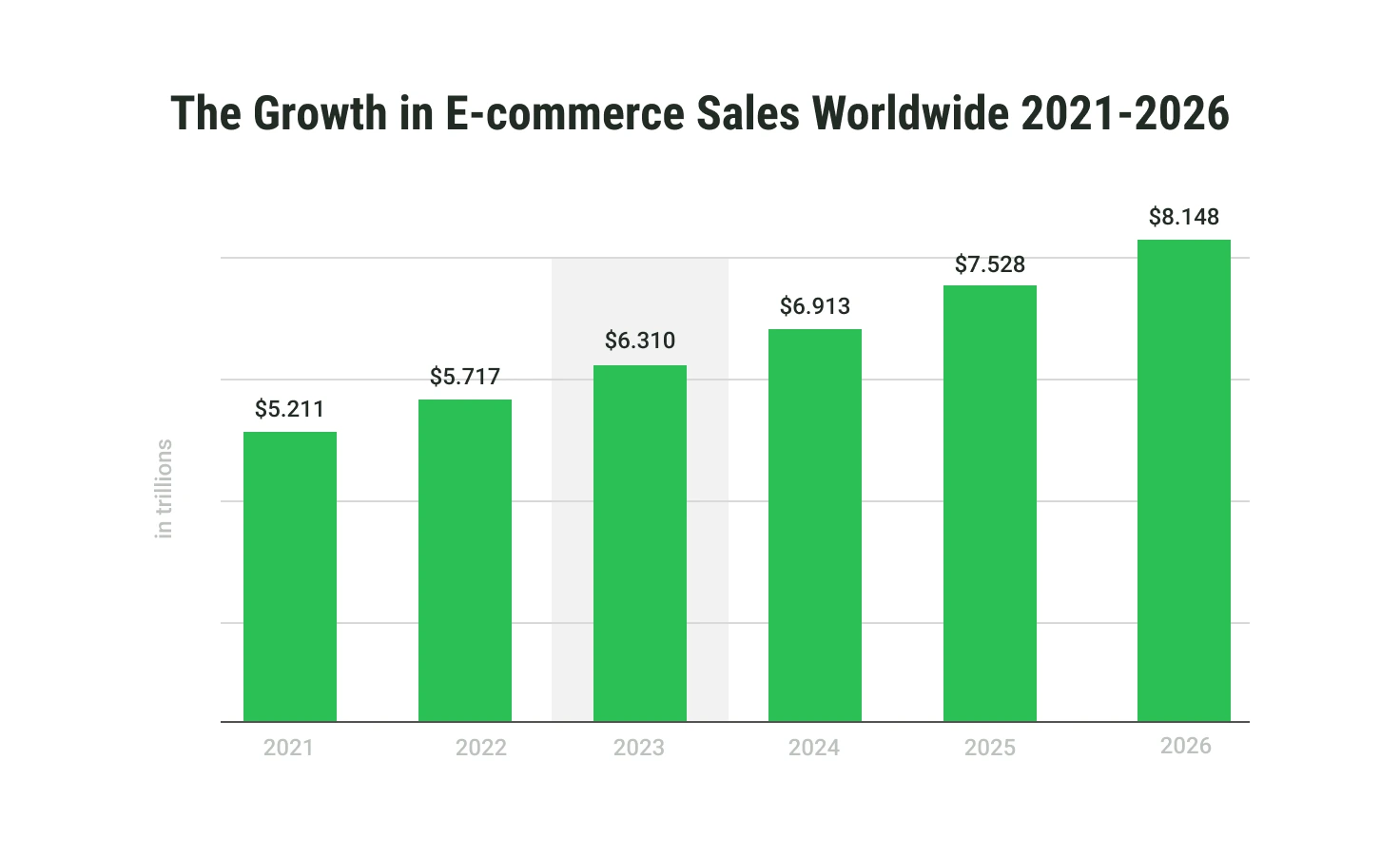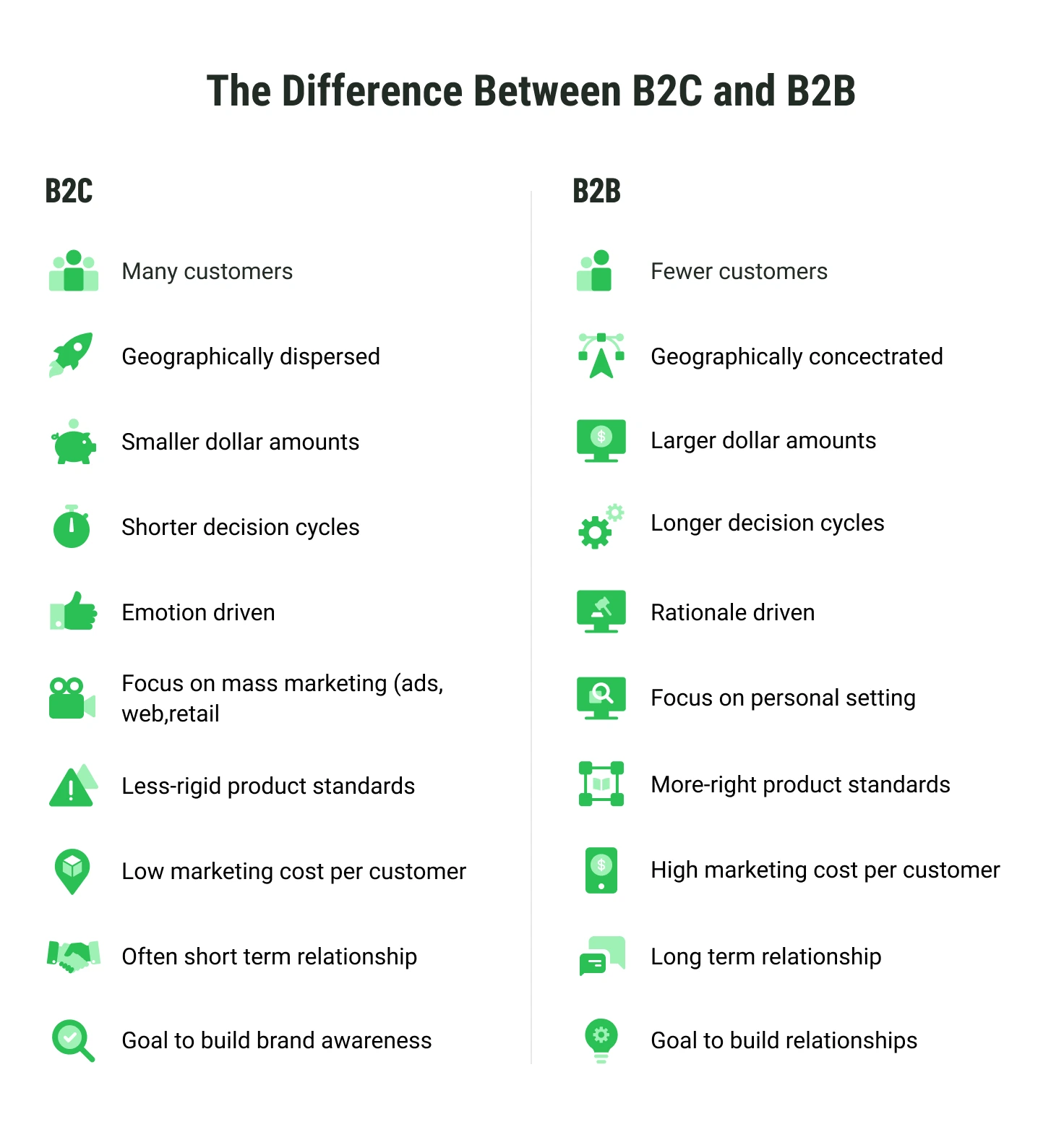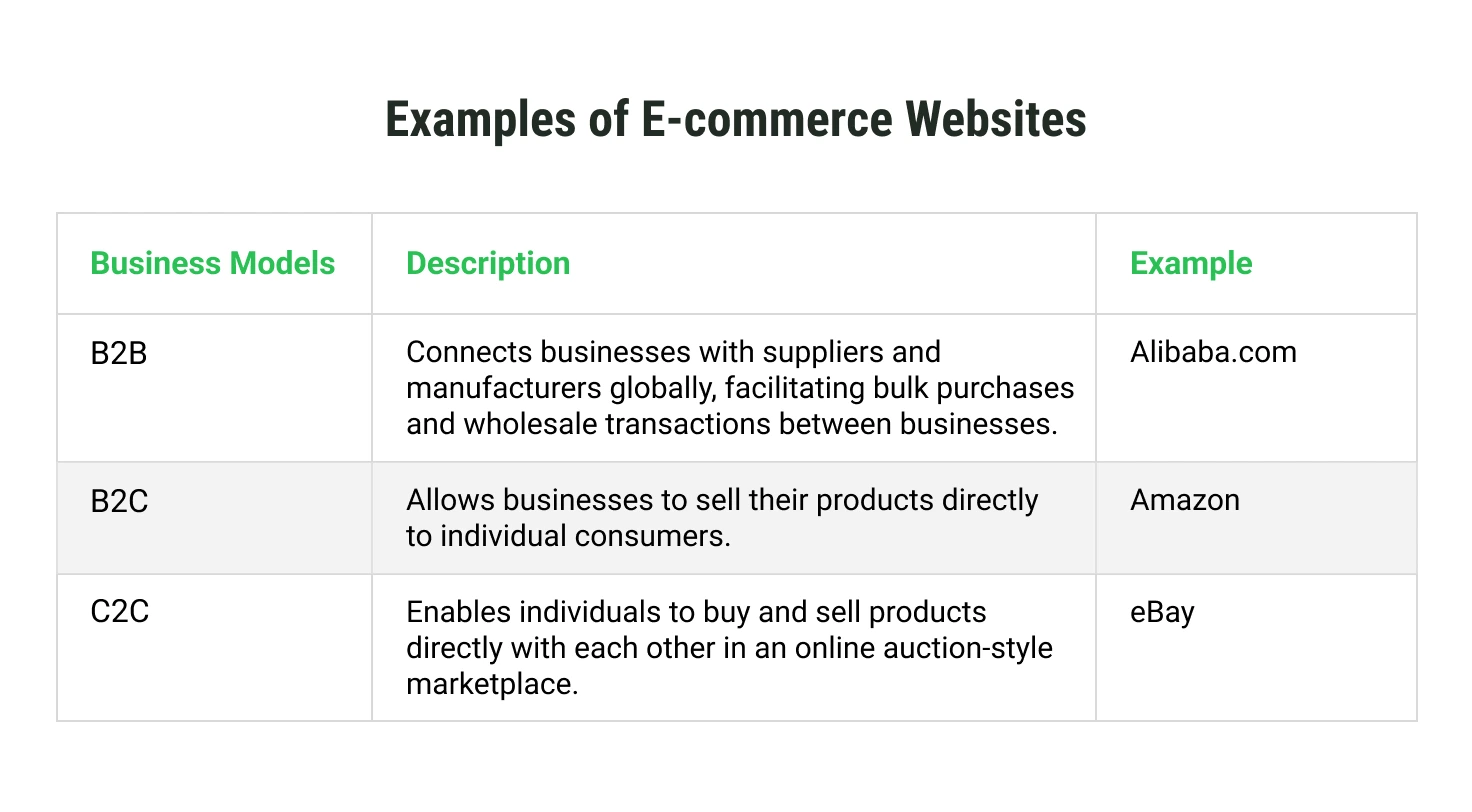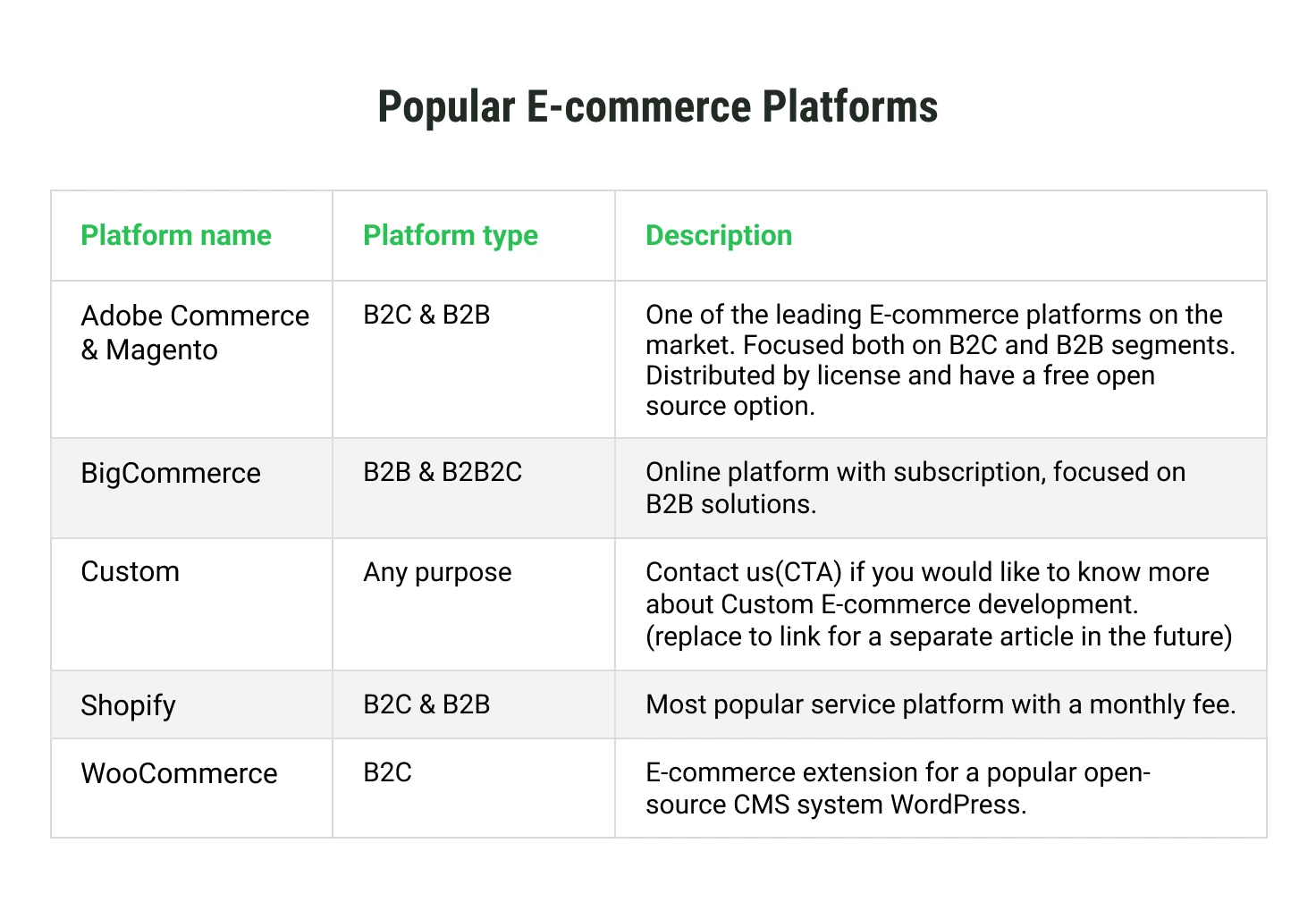Choosing an E-commerce Business Model and Platform
Table of contents
E-commerce has revolutionized the shopping landscape, becoming one of the most promising areas for development and investment. In this digital era, creative founders have abundant opportunities to turn their ideas into reality. However, with various business models available, choosing the right E-commerce platform becomes a critical factor for success, rapid growth, and increased ROI (return on investment). Making the right choice can propel your venture to new heights, while the wrong one may lead to wasted resources and missed opportunities for advancement.
To delve deeper into the world of E-commerce business models and discover the perfect fit for your enterprise, read our comprehensive article, in which you’ll explore the possibilities and unlock the potential for unparalleled success in the E-commerce realm.
Why Launch an E-commerce Business?
E-commerce, short for electronic commerce, is the buying and selling of goods and services over the internet. It involves the entire process of conducting business online, from advertising and marketing products to processing transactions and delivering goods to customers.
E-commerce has become increasingly popular due to its convenience, accessibility, and global reach, allowing businesses to operate 24/7 and reach customers around the world. The E-commerce market is growing steeply, with global retail E-commerce sales expected to be $6.310 trillion US dollars by 2023, according to Forbes.
And this trend doesn’t seem to change. More and more people use the internet to purchase goods. By 2026, 24% of retail purchases are expected to take place online, making E-commerce a valuable long-term investment for businesses.

When establishing your E-commerce store, the primary objective is to curate an exceptional online shopping experience, catering to customers worldwide, irrespective of their geographic location or preferred shopping channels. An E-commerce model serves as more than a mere sales tool; it encompasses a comprehensive ecosystem that empowers businesses, providing greater control and robust support to foster substantial growth and success.
Keep reading to learn what E-commerce business models exist and how to choose the one that best fits your business goals.
What E-commerce Business Models Exist and How to Choose One?
E-commerce business models shape the way products and services are bought and sold online. Today, the most popular models are Business-to-Consumer (B2C), Business-to-Business (B2B), Business-to-Government (B2G), and Consumer-to-Consumer (C2C). Let’s discover what the differences are between them.
Business-to-Business
In the world of B2B business models, enterprises sell their products or services to other businesses. While the buyer may sometimes be the end-user, more often, they serve as a reseller, reaching the ultimate consumer. These transactions typically encompass a longer sales cycle, but they come with higher-order value and greater potential for recurring purchases.
The report by Astute Analytica reveals that the Global Business-to-Business (B2B) E-Commerce Market is projected to reach 18,771.4 billion USD by 2027. Other reports indicate that there are more transactions in B2B markets and more high-dollar transactions because business products are often costly and complex.
Business-to-Consumer
B2C businesses directly sell their products or services to end-users, encompassing a wide range of consumer goods, from clothing and household supplies to entertainment products. The decision-making process in B2C transactions is typically shorter compared to B2B purchases, especially for lower-value items. As a result, B2C businesses often allocate lower marketing budgets to achieve sales, although they may have lower average order values and fewer repeat orders compared to B2B counterparts.
Historically, B2C E-commerce has been more widely recognized due to its direct engagement with consumers, including online retail giants like Amazon, Alibaba, and eBay. B2C transactions are generally more visible to the public, as they involve selling products and services directly to individual consumers.
B2B and B2C are the most popular E-commerce business models and often the top choices for businesses launching into the online realm. Let's explore their differences in this comprehensive table.

Business-to-Government
B2G is an E-commerce model in which businesses market and sell their products to government entities and public administrations at various levels—local, county, state, or federal. The success of this model hinges on winning government contracts through competitive bidding. Government agencies issue requests for proposals (RFPs), and E-commerce businesses must bid on these projects to secure them.
While B2G offers a more secure business avenue, it differs significantly from dealing with other businesses or consumers. The bureaucratic nature of government agencies often translates to a slower decision-making process, potentially limiting revenue streams despite their inherent stability.
Business-to-Business-to-Consumer
In the B2B2C model, companies collaborate to expand their customer bases. For instance, businesses might partner with an E-commerce platform to reach new audiences. A real-world example is Instacart, where grocery stores join forces to access more customers through Instacart's digital platform. B2B2C E-commerce employs scalable and flexible marketing campaigns to reach its audience, similar to B2C businesses.
Consumer-to-Consumer
C2C E-commerce ventures, often known as online marketplaces, foster direct connections between consumers for exchanging goods and services, generating revenue through transaction or listing fees. While C2C businesses enjoy organic growth fueled by motivated buyers and sellers, they grapple with the challenge of maintaining quality control and technology upkeep.
This model traces its roots back to the early days of the internet, with pioneers like Craigslist, Walmart, Alibaba, and eBay shaping the landscape of online consumer interactions.
To choose the right E-commerce business model for your business, consider factors such as target audience, product or service type, competitive landscape, and your long-term goals. Once you have selected the best E-commerce business model that suits your needs, it's time to choose a suitable platform that aligns with your chosen model.
Peer-to-Peer
The P2P (Peer-to-Peer) E-commerce model involves direct transactions between individuals without the involvement of a central platform or intermediary.
The main difference between P2P and C2C E-commerce is that while both involve direct transactions between individuals, C2C transactions take place on a specific online platform that facilitates the exchange. On the other hand, P2P transactions can occur through various channels beyond dedicated e-commerce platforms and may encompass a broader range of interactions, not limited to consumer-to-consumer exchanges.
Here are a few examples of E-commerce websites with different business models:

What Is an E-commerce Platform?
An E-commerce platform serves as an all-in-one software solution, empowering online businesses to efficiently manage their website, marketing, sales, and operations. With its flexibility and cloud-based nature, it facilitates memorable customer experiences, streamlines operations, and opens doors to phenomenal growth opportunities.
E-commerce platform choices are essential for businesses looking to establish a strong online presence and reach a global customer base. So, when making your decision, consider four essential factors:
- Scalability for rapid expansion
- Ongoing running costs
- Built-in customer engagement tools
- Platform's level of customer service to support conversion, loyalty, and retention.
Even with the knowledge of these factors to consider, choosing the right platform can still be challenging. So let’s discover the most popular platform that exists today.
According to our research using a number of sources, we collected the market share of leading E-commerce software platforms and technologies worldwide for Shopify, WooCommerce, Custom, Adobe Commerce(Magento), BigCommerce, and others as of July 2023.

Summary
E-commerce is a thriving sector with significant development and investment opportunities. The convenience, accessibility, and global reach of E-commerce have contributed to its widespread popularity, with global retail E-commerce sales expected to surpass $6.310 trillion by 2023.
Choosing the right E-commerce business model and platform is vital for achieving success and maximizing return on investment. Different business models cater to various market segments, such as Business-to-Business (B2B), Business-to-Consumer (B2C), Business-to-Government (B2G), and Consumer-to-Consumer (C2C), each model coming with its own unique considerations and potential benefits.
When navigating the world of E-commerce, having a reliable partner can make all the difference. Emerline is an E-commerce solutions development company with proven expertise in this domain. Our team is ready to assist you in establishing your E-commerce venture, regardless of whether you're just starting out or looking to expand your existing business. We offer a wide range of services and flexible collaboration models to cater to your specific needs.
If you want to leverage the power of technology to reach more customers or need guidance in your E-commerce journey, book a free consultation with our experts. Together, we can unlock the true potential of your E-commerce enterprise.
Updated on Jan 8, 2024





